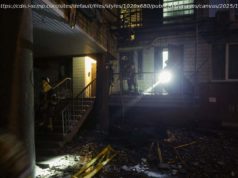So far, at least 30 people have been reported dead and about 70 people were missing after a fire in London’s 24-story Grenfell Tower.
NEW YORK (AP) — A catastrophic blaze at a London apartment tower has brought new scrutiny to a long-accepted, counterintuitive rule for people in tall buildings: If the blaze breaks out elsewhere in the structure, don’t automatically run for the stairs. Stay put and wait for instructions.
That’s what residents of London’s 24-story Grenfell Tower had been told to do, but the strategy failed early Wednesday when flames that began on a lower floor spread shockingly fast and quickly engulfed the entire building. Many residents were trapped, forcing some on higher floors to jump to their deaths rather than face the flames or throw their children to bystanders below. So far, at least 30 people have been reported dead and about 70 people were missing.
Despite that outcome, fire experts say “stay put” is still the best advice — as long as the building has proper fire-suppression protections, such as multiple stairwells, sprinkler systems, fireproof doors and flame-resistant construction materials, some of which were lacking in the London blaze.
“It is human nature for most of us — if we know there’s a fire, start moving and get out, ” said Robert Solomon of the National Fire Protection Association, a U. S.-based organization that studies fire safety globally. “But we try to make sure people know there are features and redundancies in buildings that you can count on, and you can stay put.”
London apartment fire: More survivors would be a ‘miracle’
Most major cities with many high-rise buildings have detailed building codes and fire safety rules requiring several layers of protections in tall buildings. The rules vary from place to place, as does advice about when to evacuate, but fire experts say the “shelter-in-place” directive is usually applied to buildings of 15 stories or more.
Floors directly above and below the reported fire are usually evacuated, but others are to stay and use damp towels to block cracks beneath the door unless told otherwise, and call 911 if they have questions.
That’s partly to avoid repeated, unnecessary evacuations that cause people eventually to ignore such orders when they really matter. And it also avoids panicked and unsafe evacuations down a long stairwell choked with smoke, which can be just as deadly as the licking flames.
Several such high-rise evacuations over the years have resulted in needless deaths. In 2014, a man who fled his apartment on the 38th floor of a New York City apartment building died when he encountered a plume of suffocating smoke in a stairwell as he tried to descend to the street. His apartment remained entirely untouched by the flames.
What makes the London fire maddening for fire experts who believe in the “stay put” rule is that the Grenfell may have lacked many of the safety redundancies necessary to make it work.
For example, the Grenfell building had only one stairwell. A lawmaker says it didn’t have working sprinklers. And Britain’s Guardian newspaper reported that cladding used on the high-rise structure was made of the cheaper, more flammable material of two types offered by the manufacturer.
“The bottom line: Sprinklers, fire doors and multiple stairwells work, ” said Chicago Fire Department Battalion Chief Michael Conroy. “It becomes difficult to shelter-in-place when you have no engineered fire protection systems within a building.”
London high-rise apartment building on fire






